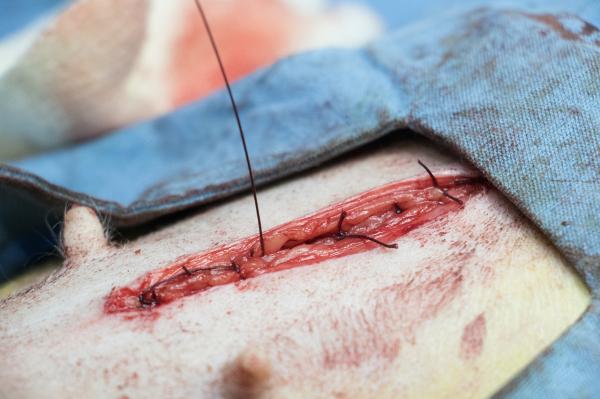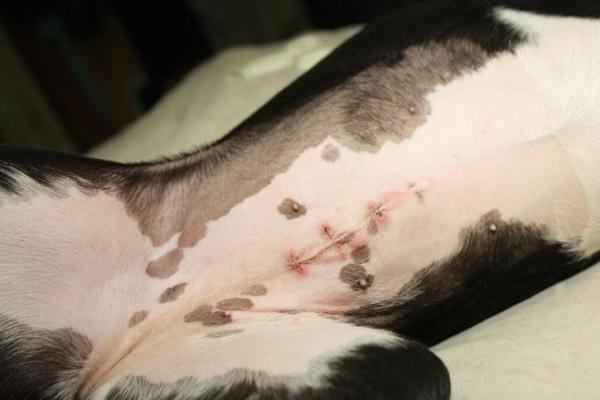
Sterilizing a dog has many benefits. Whether spaying a female dog or castrating a male dog, it is a procedure recommended by veterinarians as it helps reduce dog abandonment, prevents certain diseases and reduces the risk of behavioral problems. Complications from the procedures are rare. However, as they are surgical interventions, there are still risks which needs to be taken into consideration. Even the fact that surgery is carried out at all makes some dog guardians question if it is worth the operation.
This is why AnimalWised tells you more about possible complications after spaying or neutering a dog. We show you how the risk does not outweigh the benefits, but also what signs and symptoms we need to be observant of in the unlikely case a complication does arise.
What is neutering a dog?
Sterilization is the process rendering of an animal infertile. However, not all sterilization is permanent. For example, causing a dog to be fertile through medication will not be effective once the medication is stopped. Neutering, on the other hand, is the process of making an animal permanently infertile, in the majority of cases irreversibly.
Neutering is different for males and females:
- Male dogs: castration is the main form of neutering which involves the removal of the dog's testicles. Doing so not only prevents the production of sperm, but it also stops behavior changing hormone production linked to aggression and other problematic issues.
- Female dogs: spaying in the process of removing the dog's ovaries (oophorectomy) or both the ovaries and uterus (ovariohysterectomy). Both forms prevent eggs and hormones being produces due to removal of the ovaries. However, an ovariohysterectomy is recommended by veterinarians because it also prevents diseases such as uterine cancer and pyometra in dogs.
The hormones produced in the sex hormones influence many factors in the dog's physical and behavioral development. Neutering eliminates the majority of testosterone and estrogen production in a dog's body. The result is a reduction of sexually dimorphic behaviors, i.e. behaviors specific to each sex. For example, a female dog will no longer have her estrus cycle and will not display the erratic behaviors of heat. Male dogs will be less aggressive as they have no need to compete for a female and will generally carryout less urine marking behavior.
However, when the neutering procedure takes place will have some effect on behavioral changes. For example, if the dog is neutered after they have become sexually mature, they may still exhibit certain behaviors afterwards. will see the main benefits if you are thinking of castrating your dog. Below we will look into some of the specifics according to canine sex.
Benefits of neutering a male dog
Although a dog may remain fertile for a short period after castration, eventually the procedure will permanently prevent them from being able to reproduce. In addition, this intervention means they will:
- Avoid litters of unwanted puppies: the history of canine domestication means that dogs have breed breed to the point that there are not enough families to care for all of the puppies being born. Some will be homed in shelters, but this system is under great pressure and the result is often dog abandonment and, often, euthanasia. Preventing unwanted pregnancies in dogs means we can better care for the dogs we have already.
- Avoid escaping: male dogs want to copulate because their hormones are telling them to do so. Their drive is so strong, they will often flee their home to pursue a female and become lost in the process. Roaming dogs pose a danger to themselves or others, especially during periods of high sex drive. Microchip implants in dogs can help return an escaped dog.
- Reduce intrasexual aggressiveness: male dogs compete with each other to mate with females, motivated by sexual hormone production. However, we also need to be aware that castrating a dog is only one influence on a dog's aggressiveness. This problem is also influenced by many other factors such as environment, education and socialization. Castrating reduces intrasexual aggression, but it does not solve other problematic aggressive behavior.
- Prevents various pathologies: castration serves as a prevention for the development of tumors in the testicles and reduces the risk of developing benign prostatic hypertrophy (hyperplasia). The sooner the procedure is carried out, the more effective its preventive aspects will be.
Below you can see the incision of a female dog after the spaying procedure:

Benefits of castrating a female dog
Neutering a female dog also has a number of benefits, including:
- Avoid litters of unwanted puppies: clearly, by losing their reproductive capacity there is no longer the possibility that the dog will become pregnant. As we have already mentioned, this allows the control of unwanted litters. A family with a male dog which impregnates a female will not necessarily have any responsibility over the puppies. If you have adopted a female dog which becomes pregnant, you will have to look after their well-being as well as the future well-being of her puppies.
- Avoid heat period: spaying means the female dog will no longer go into heat. This is an advantage to the dog as they will not develop the frustration which comes with this process, but it also helps their guardians who do not have to deal with their problematic behavior. They will also avoid male dogs trying to mate with her.
- Avoid pseudopregnancy: spaying eliminates pseudopregnancies, also known as phantom pregnancies. This is something which can cause serious health problems in the long-term. Our article on phantom pregnancy in dogs will help explain more.
- Prevent various pathologies: as with castration in males, spaying in females is also a preventive for the development of mammary tumors and uterine infections such as metritis which can be life threatening.
The photo below is of a sutured incision of a spayed female dog:

Complications of neutering a dog
Again, we need to stress that the probability of having complications from neutering a dog is slim when we take make the proper safeguarding precautions. It is considered minor surgery. However, we still need to be vigilant in case any of the following arises:
- Hematomas, irritations and swelling: that the incision site for castration or spaying will be swollen, red or may have some scabbing. However, it is a wound which should heal relatively quickly. In male dogs, it may even appear as if they still have testicles in their scrotum, but this is due to swelling and it will subside after a few days. This means it is not a postoperative complication of neutering. However, if the swelling becomes too acute or there are purulent secretions, you need to go back to the veterinarian.
- Vomiting and diarrhea: due to general anaesthesia, your dog will be slightly dizzy and their metabolism altered. This may manifest in vomiting and diarrhea. However, you will need to monitor them as, if it continues for more than 24 hours, you will need to go back to the veterinarian.
- Ovarian remnants: in some female dogs, it is possible that some ovarian tissue will remain after surgery. This can lead to hormonal issues, infections or other problems. This is why, on very rare occasions, even spayed dogs can get diseases such as pyometra.
- Infection risk: the risk of your dog suffering an internal infection is minimal, but we should always check for signs in case the dog's belly becomes swollen and hard. However, since the incision site will likely irritate the dog, they will be inclined to lick the wound area. For this reason, we need to put an Elizabethan collar around their neck to prevent this from happening as bacteria from their mouth can infect the wound or they may remove the stitches.
- Poorly healed wound: similarly, if the dog licks the incision or it is knocked against something, it is possible that the wound will not heal properly. In these cases, we need to take them to the veterinarian as medicating them ourselves can make the situation worse.
- Death: the risk that any dog guardian fears. Placing a dog under general anaesthesia can seem like a drastic action. It is possible they may have an adverse reaction which results in their death. However, it should be noted that multiple studies have shown that the mortality rate for neutering in dogs is practically negligible at 0.03%[1].
Consequences of neutering a dog
Spraying and castration are common surgical procedures which have relatively few complications. As we have seen in the previous section, there is a very low mortality rate and other complications can be treated easily. If you take your dog to a qualified veterinarian, you should know the dog is in safe hands.
However, neutering will have repercussions on your dog's health which need to be considered for their general health and well-being. While normal and manageable, the consequences of neutering a dog include:
- Increased risk of obesity: there is a tendency for neutered dogs to gain weight more easily due to hormonal differences. However, it is a myth that neutered dogs will become obese as a matter of course. Obesity is caused by excess food and lack of exercise since they do not burn unnecessary calories. As long as we provide a balanced diet and sufficient opportunity to exercise you can avoid the consequences of obesity in dogs.
- Increased risk of urinary incontinence: in females, inappropriate urination can occur due to an imbalance of estrogen in the blood. For this reason, it is one of the most common consequences of neutering a female dog.
- Possibility hypothyroidism: there is also an increased risk of possible hypothyroidism in dogs. If this does result, it can be managed with suitable medications.
- Increased aggressiveness in females: a non-neutered bitch will be able to balance her levels of male and female hormones. However, as a consequence of neutering, the level of female hormones will decrease and will result in high levels of testosterone. Especially with females with prior aggression problems, aggression can develop or worsen. For this reason, veterinarians may assess female dogs with aggression issues differently from others.
- Possibility of bone fracture: when a not yet fully developed dog is neutered, there is an increased risk of bone fracture. This is because the hormones which influence bone growth are also produced in the sexual organs. Neutering a dog too early is considered veterinary malpractice. For this reason, we need to provide the right details about our dog to the vet.

When will we observe negative effects of neutering a dog?
There is no specific period of time in which you can begin to observe changes in your dogs behavior or personality. It will depend on too many factors and also the time of complication. For example, a wound will not become infected after it is healed, but you may not see changes in a dog's behavior until some time after the operation takes place.
You are unlikely to see behaviors in a dog which did not exist prior to the surgery. A dog which had not marked inappropriately before, will be likely to do so after castration. Dogs which have been neutered after they have reached sexual maturity, may still exhibit some problem behaviors, but this does not mean they will start new ones. We cannot accurately predict the exact behavior of a dog post-neutering as all are individuals.
We should be clear that changes to the dog's behavior and even physical health will not likely be immediate. Generally, a period of between 4 and 6 months will be sufficient time to see if the neutering procedure has affected their behavior positively or negatively. As dog guardians, we need to be observant for any possible changes to their well-being and address them with a veterinarian as soon as possible.
Regardless of whether your dog has been neutered, we always need to be vigilant against any possible signs your dog may be sick. We explains these symptoms in the video below:

This article is purely informative. AnimalWised does not have the authority to prescribe any veterinary treatment or create a diagnosis. We invite you to take your pet to the veterinarian if they are suffering from any condition or pain.
If you want to read similar articles to Complications After Spaying or Neutering a Dog, we recommend you visit our Prevention category.
Levya, J. K., at al. (2017). Perioperative mortality in cats and dogs undergoing spay or castration at a high-volume clinic. The Veterinary Journal, 224, 11-15. DOI: https://doi.org/10.1016/j.tvjl.2017.05.013
- O'Hare, J. (2003). The effects of spaying and neutering on canine behavior.
- Benjamin L. Hart, Robert A. Eckstein (1997). The role of gonadal hormones in the occurrence of objectionable behaviors in dogs and cats . Applied Animal Behavior Science 52, 331-334.
- Laura J. Sanborn, MS (2007). Long term health risks and benefits associated with spay and neuter in dogs .